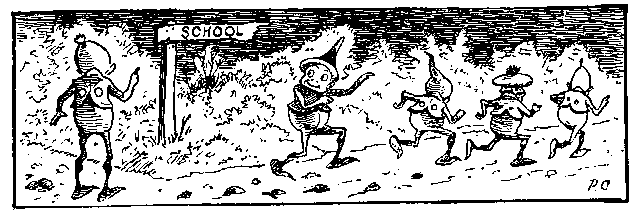THE BROWNIE
by A.A. Milne (from When We Were Very Young, 1924)
In a corner of the bedroom is a great big curtain,
Someone lives behind it, but I don’t know who;
I think it is a Brownie, but I’m not quite certain,
(Nanny isn’t certain, too.)
I looked behind the curtain, but he went so quickly —
Brownies never wait to say, “How do you do?”
They wriggle off at once because they’re all so tickly
(Nanny says they’re tickly too.)
Come to think of it, I’ve always had a thing for little men.
You know, those cute, industrious little sprites who do your housework while you’re fast asleep and never make a sound? They like to make mischief, but never do any harm. In fact, they’re here right now, but of course grown-ups can’t see them.
Since this is Leap Year, and we have an extra special bonus day, I thought it only fitting to give Love and Chocolate Month a proper send-off with a BROWNIE celebration.
You know, just the word, brownie, makes me feel good. It’s childhood, warm and safe, all wrapped up in one. I think of class parties, picnics, pot-lucks, teas, the special treat in a lunchbox. And nothing tops that chocolatey aroma filling the kitchen with the promise of a warm brownie to come! Mmmmmm!!
They say brownies were named after Palmer Cox’s Brownie books (16 in all), which were very popular during the late 19th century. All the stories were written in rhyming couplets, and featured hundreds of charming sprites (all male) working and playing together in all kinds of scenarios — skating, fishing, going to school, building a snowman, racing, yachting, and painting, etc.
Each Brownie had a name, but none were ever set as characters in a plot; Cox instead always featured them as a massive group. What is interesting is that Cox nevertheless drew them as individuals of different races and professions — so there’s an Indian chief, a policeman, an Irishman, German, Cowboy and Chinese peasant. This was not a time of widespread acceptance for ethnic minorities, yet somehow the Brownies managed to escape controversy.
The first Brownie story actually appeared in St. Nicholas Magazine (1883), closely followed by The Brownies: Their First Book (1887). Cox’s characters were based on the sprites of English and Scottish folklore, well known to him as a child in Quebec. Today he is considered a “pioneering artist of the Platinum Age of Comic Art.”
His highly detailed black and white illustrations are as charming today as they were in the 19th century, when it became a national pastime for readers to pick their favorite Brownie and follow him throughout the book. The little rascals race across the page, drop their fishing lines down the margin, and wrap themselves around the text (a precursor to today’s graphic novel?). The imaginative, funny verse stories are worth examining from a historical standpoint, but without central characters they can become repetitive.
*

THE BROWNIES AT SCHOOL (from The Brownies: Their First Book, 1887)
As Brownies rambled ’round one night,
A country schoolhouse came in sight:
And there they paused awhile to speak
About the place, where through the week
The scholars came, with smile or whine,
Each morning at the strike of nine.
“This is,” said one, “the place, indeed,
Where children come to write and read.
“T is here, through rules and rods to suit,
The young idea learns to shoot;
And here the idler with a grin
In nearest neighbor pokes the pin,
(Rest of this story here.)
In case you’re wondering, the Kodak Brownie Camera was named after the books, and Cox is recognized as a pioneer in the field of licensed merchandising, predating Disney by decades. He allowed his Brownies to appear on everything from soap to puzzles, games, dolls and figurines.
All this sales talk is making me hungry. Excuse me for a bit, while I take a batch of brownies out of the oven.
Okay, I’m back. The first mention of brownies appeared in the 1897 Sears Catalogue, but it referred to a type of candy, instead of cake. The first brownie recipes (using chocolate instead of molasses) came from Boston and Maine (1906-07). Story goes, A Bangor housewife made a chocolate cake which fell, and rather than toss it out, she cut it into squares. Thank god for New England frugality!
Here’s my favorite brownie recipe. It’s not one of those overly-rich, double chocolate chip jobs, but more of a good, basic (nuts or no) recipe for all times. If you like fudgy brownies, underbake by a few minutes; otherwise it will have more of a cakey texture. For the ultimate brownie experience, wear brown during preparation, and ask your husband or somebody to clean the house (quietly) while you’re asleep. Yay, little men (I married a Rattigan leprechaun)!
JAMA’S FAVORITE BROWNIES
2 sticks butter
2 squares Baker’s unsweetened chocolate
1-1/2 cups flour
1 tsp baking powder
1/2 tsp salt
4 eggs
2 cups sugar
2 tsp vanilla
2 cups nuts (optional)
4 tsp corn syrup
Melt butter and chocolate together over hot water. Cool.
Sift flour with baking powder and salt. Set aside.
Beat eggs until light. Add sugar, chocolate mixture and blend in corn syrup.
Add flour, vanilla, and nuts and mix well.
Bake in 9″ X 13″ pan coated with butter and flour in 350 degree oven for 30-35 minutes.
Cool and cut into squares. Sprinkle with powdered sugar.
*
Tantalizing links:
A not-to-be-missed page featuring Brownie Camera memorabilia and all the covers of the Brownie books.
All about Palmer Cox and the books.
Historical brownie recipes (scroll down).
Today’s Poetry Friday hostess is the lovely, Austenish Kelly R. Fineman, at Writing and Ruminating. She’ll be graciously serving a roundup of poems and some soulful tea!
Thanks so much for stopping in. You’ve definitely earned some brownie points!
